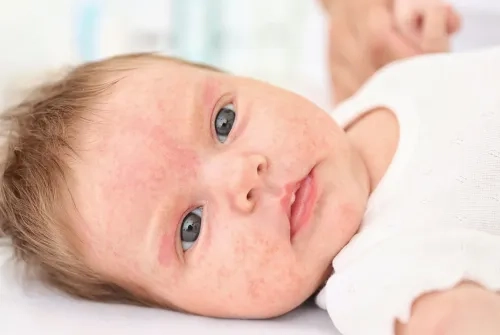Alo Yeditepe
Alo Yeditepe
The Most Common Skin Rashes in Newborns
Various skin rashes that occur in children from the neonatal period cause anxiety for mothers from time to time. Pediatrics Specialist Dr. Perihan Çobanoğlu Saf gave information about the 6 most common skin diseases.
In the neonatal period, colorful rashes may occur due to the fact that the skin is much more sensitive and vulnerable to external factors. Underlining that newborn rashes are much more innocent than is thought, Yeditepe University Kozyatağı Hospital Pediatrics Specialist Dr. Perihan Çobanoğlu Saf said, “While newborn rashes can rarely be a symptom of important diseases, they usually appear as very innocent things.”
“Mongolian Spot Should Not Worry Mothers”
Specialist Dr. Perihan Çobanoğlu Saf, who gave information about the Mongolian spot, which is more common in dark-skinned babies, said, “It manifests itself as a bruise that appears in the area extending from the waist to the hips. This situation, which may worry any mother who holds her baby in her arms, is actually completely unimportant. It is not known why the Mongolian spot occurs. This spot, which is observed together with the birth, is in the form of a bruise extending upwards from the coccyx, which is at least 5-6 cm. It disappears around the age of 2 and is completely unimportant. It has nothing to do with Down syndrome.”
“Milia Spot Disappears in 2 Weeks”
Specialist Dr. Perihan Çobanoğlu Saf, who stated that the milia spot on the face of babies is a pinhead-sized bump, said, “These spots, which shine like pearls and do not cause any problems, are completely innocent and disappear in 1-2 weeks.”
The Most Common Toxic Erythema
Dr. Perihan Çobanoğlu Saf explained that another common rash in the neonatal period is 'toxic erythema', which is seen in the form of reddish yellow-white bumps similar to acne, and continued as follows:
“This rash, which appears within 1-2 days after birth, is not inflammatory, contrary to its appearance, and usually disappears within a week. However, if this spot occurs immediately after birth or after 5-6 days, if there is accompanying restlessness, fever, or if it does not regress within 3-4 days, it is necessary to consult a doctor.”
Hemangiomas
Dr. Perihan Çobanoğlu Saf stated that the rash that appears as a red spot on the baby's skin after birth, alarming many families and causing concerns like "Will there be any scars? Why does it happen?", is hemangiomas, and made the following statement: “Families are generally concerned that hemangiomas that are usually observed on the eyelids, nostrils, above the lips, between the eyebrows and on the back of the neck will be permanent. Among the people, these spots are known as 'birthmark' or 'stork bite' (based on the legend of the redness where the stork grabs the baby with its beak while bringing it). Although these known spots are attributed to the consumption of red fruits such as strawberries and pomegranates during pregnancy, they have nothing to do with them.
These rashes, which are light red, ranging from 1-2 cm to 5-6 cm, are usually not raised from the skin. However, in cases where it is intense, swelling may occur. It is caused by the condensation and expansion of capillaries to form a vascular bundle. It becomes more evident when the baby cries, strains, and laughs. The big and intense ones can grow from 4-5 months to 1-1.5 years old, then they start to shrink. It usually disappears around 4-5 years of age. In some cases, hemangiomas that are raised from the skin may require treatment. A pediatrician should monitor these. Other pink-red ones that are not swollen disappear completely on their own between 1-2 years of age.”
Precautions Against Heat Rash
Dr. Perihan Çobanoğlu Saf, who stated that heat rash is the most common rash in babies, continued as follows:
“It occurs as a result of clogged sweat glands in hot weather. It is more common in younger babies because their sweat pores are also smaller. This is due to the fact that babies are dressed thickly in hot weather. First of all, clothes that are as thin as possible and absorb sweat should be chosen for babies so that their skin can breathe. Bathing should be done frequently. They should be kept in an airy environment. Their diapers should be changed frequently and ventilated for at least 15 minutes a day. Products such as baby oil or intense moisturizers should not be applied to their skin unless necessary. Complaints usually regress spontaneously with these care suggestions. However, in cases where heat rash is widespread, it may be necessary to use lotions recommended by the pediatrician.”
Seborrheic Dermatitis
Yeditepe University Hospital Pediatrics Specialist Dr. Perihan Çobanoğlu Saf said that 'seborrheic dermatitis, a common type of rash, is seen on the eyebrows and eyelids, on the forehead, and behind the ears, and that these rashes, which are seen in the first three months, will mostly go away on their own, and made the following statement about the treatment:
“This may require the use of a zinc or cortisone cream under the supervision of a doctor, although this is rare for babies. The common form of this that occurs on the scalp is called the milk crust. Softening with olive oil, washing with shampoos produced for babies every other day, and then combing it with the back of the comb, that is, the flat part of the comb, alleviates the situation, but it should never be removed by force. Rash and allergic atopic dermatitis are also among the most common problems.”
Press Coverage: milliyet.com | posta.com | cnnturk.com | mynet.com
This content was prepared by Yeditepe University Hospitals Medical Editorial Board.
Alo Yeditepe








